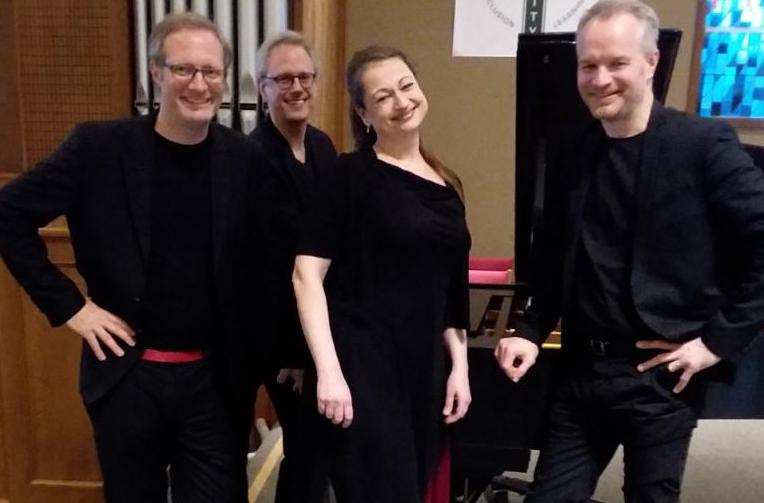Rare Mahler Quartet at Mill Valley Chamber Society (2019)

Fauré Quartett at Mill Valley March 24 (A. Wasserman Photo)
RARE MAHLER QUARTET AT MILL VALLEY CHAMBER CONCERT
by Abby Wasserman
Sunday, March 24, 2019
Piano quartets are relatively rare in the classical literature, and there are only about 40 compositions for the combination of piano, violin, viola and cello, mostly from the Romantic period of the mid to late 1800s. It therefore was special March 24 to hear three great works of this medium, performed by the Fauré Quartett from Germany in Mill Valley Chamber Music Society’s season closer at the Mt. Tamalpais Methodist Church.
The Fauré (Dirk Mommertz, piano; Erika Geldsetzer, violin; Sascha Frömbling, viola; and cellist Konstantin Heidrich) presented penetrating readings of works by Mahler, Fauré and Brahms (plus a tantalizing quasi orchestral encore). They opened with Mahler’s one-movement Quartettsatz in A Major, composed in 1876 when he was sixteen. It is elegiac and passionate, and this was a particularly nuanced reading that despite the repetition of its motifs and themes, was never boring. Mahler apparently didn’t think much of it, and after his death it was discovered under a stack of papers by his widow Alma. He may have intended it to be the first movement of a larger work but that never happened, and no other chamber ensemble work by Mahler survives. The quartet was not performed publicly until 1964.
Beginning with a brief spare, thoughtful piano introduction, the strings joined and soon the piano introduced repeating triad chords in the right hand as the left played a somber bass melody; this would be repeated further on. There were many mood and tempi changes as the main theme was explored. The music moved through turbulent emotions, and seemed at times like an obsessive meditation on life and death, with passion and tenderness. Ms. Geldsetzer’s playing showed an astonishing range, summoning multiple shades and many voices. Mr. Frömbling’s viola sang brilliantly, and Mr. Mommertz’s virtuosic pianism was at turns sweet and thunderous. Throughout the work Mr. Heidrich’s cello grounded the interpretation with a golden sonority. The audience was silent when it ended, waiting for the musicians’ bows and hands to be lowered, then breaking into appreciative applause. It was hard at that moment to imagine a more nuanced or heartrending reading of the piece.
Fauré was celebrated during his lifetime but little appreciated outside of his native France, and international recognition came later. The Piano Quartet in C Minor, Op. 15, was first performed in 1879, though the last movement was revised in 1883. It was written straddling highs and lows in his life. The first movement, (allegro motto moderato) is like a happy conversation among the four instruments. The melody wanders blithely, sometimes with a distinct Ravel-like air, and ends gently. The allegro vivoscherzo has exciting pizzicato sections while the piano line leaps and gambols and takes thematic precedent. There are short spurts of close harmony in the strings while the piano leads a merry chase. The third movement adagio reflected the sorrow of Fauré’s broken engagement, with sighs and wistful recollections of happiness now lost. Toward the end, the piano phrases wandered up and down in this landscape of loss, then finally found strength and resolve, and the movement ended philosophically. The last movement (allegro molto) was taken at a brisk tempo, with dazzling scale passages by Mr. Mommertz. The piece resolved finally in the key of C Major. At the conclusion the audience, which nearly filled the hall, stood in excited ovation.
The very first performance in 1861 of Brahms’ G Minor Piano Quartet, Op. 25, featured pianist Clara Schumann. It is a profound work with a royal feeling, simultaneously complex and transparent. The composer Arnold Schoenberg orchestrated the piece in 1937, and his impulse to do so is understandable, since it is orchestral in nature, with thrilling blends that evoke a much larger ensemble. In the allegro first movement the piano playing was incandescent, the string sound translucent, and all were woven tightly together with insistent pulse and beautiful unison playing. The intermezzo/allegro, ma non troppo/trio/Animato often changes moods and tempi and at times hangs on the edge of dissonance. A sense of urgency prevailed as drama built and climaxed in animated piano arpeggios.
The third movement, andante con moto, was almost painful in its longing. The Fauré’s musicians seemed to live each moment with utmost feeling, their bodies and Ms. Geldsetzer’s face expressing each emotion. The section turned military, with a march and the evocation of drums, out of which the violin seemed to sing of life continuing, its rich voice rising above the other performers. The rondo fourth movement was played as an earthy gypsy celebration, Hungarian in sound, with much rubato and a vehement and joyful ensemble. The strings played unison pizzicatos while the piano part featured a cascade of notes. There was a section of waltz, perhaps bringing to mind Vienna where Brahms was living. The players seemed to be having fun with this exciting masterpiece.
When the last notes died away, the audience again rose as one to give an enthusiastic standing ovation that moved the musicians to sit again to play Mr. Mommertz’s arrangement of Mussorgsky’s “Great Gate of Kiev” from his piano work Pictures at an Exhibition. It was a grand finale encore.
Published March 27, 2019 at classicalsonoma.org.
